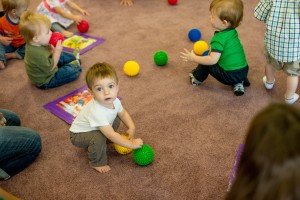Sensory play that engages in more than one sense, helps build neural connections and supports language development, cognitive growth, fine motor skills, and problem solving skills. Learning that involves multi-sensory crossovers and sense-memory is more likely to stick. It’s like glue to the brain.
Use sign language with baby!
Sign language is multisensory – you can see it, feel it in your own hands, and hear the words as we speak them while signing. That’s a big reason why it’s so helpful for language development.
Play with rhymes like this:
Wash the dishes, wipe the dishes (rubbing gently on baby’s arms and legs)
Ring the bell for tea! [say “ding, ding”] (tap on baby’s nose)
Three good wishes, three good kisses, I will give to thee! (gently swing baby’s arms or legs from side to side)
1 [kiss]
2 [kiss]
3 [kiss]
and include some tickling! It provides tactile stimulation, social development, and body awareness.
Play a favorite song!
Bounce, dance, move, make sounds, and play! To add suspense, count with your fingers to ‘1…. 2…. 3!!’ when starting something new with the song.
Join our Kindermusik Baby classes for a weekly serving of delightful music, filled with instruments, props, and plate full of multi-sensory play.

Using multi-sensory play with Kindermusik songs as babies, leads into toddlers using multiple senses to match the steady beat (moving to the beat, watching scarves bounce to the beat, hearing the shakers shake to the beat, feeling Mommy bounce me to the beat). Preschoolers use multiple senses during pretend play, leading into musical discovery (See the ‘snowflakes’ falling from the sky, hear the twinkly sounds of the bells as the snowflakes fall, hear the downward glissando on the glockenspiel, representing those falling flakes). Big kids in Young Child classes use multiple senses to understand musical concepts they can transfer to instrument play (moving feet to ‘tah’ and ‘tee-tee’ sounds directly transfers to hands playing quarter and eighth note rhythms on the glockenspiel; playing ‘quiet’ and ‘loud’ music games transfers to playing ‘piano’ or ‘forte’ on instruments.


Leave a Reply